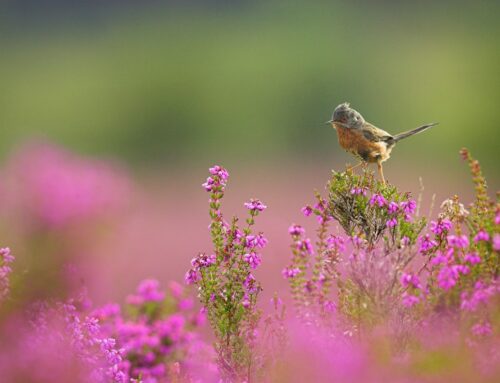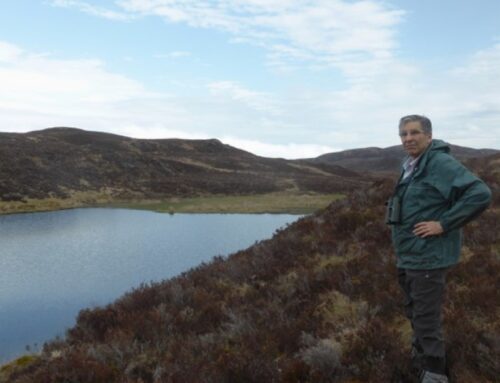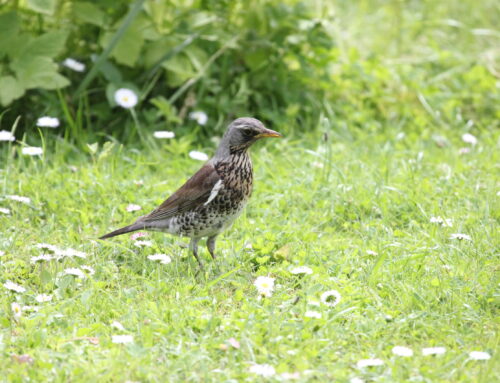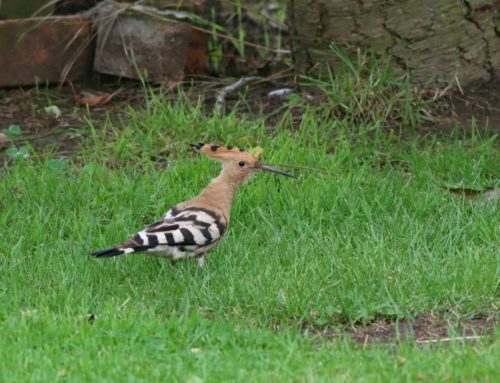What to look for in May
May – is there a more glorious time of year? The weather is improving, the breeding season is in full flow throughout the country, and the lengthening days means there is plenty of time to get out looking for rare breeding birds wherever you are. As we move towards mid-May, here’s some tips to help you find rare breeding birds and – crucially – make good records to help the Rare Breeding Birds Panel monitor their populations.
As always, the welfare of the birds must come first, and we are now in the period where many species will either have eggs or are feeding young in the nest – disturbance, whether accidental or reckless, can be detrimental to their breeding success. It may also be illegal – many rare breeding birds are listed on Schedule One of the Wildlife and Countryside Act 1981, so disturbance at or near the nest is illegal unless covered by a special licence issued by or on the behalf of the relevant statutory conservation body. It’s also wise to remember that even if you behave responsibly around rare breeding birds, others may not, so use caution about sharing news on species that are breeding or may do so – you can read our advice on this here.
This year appears to be a good one for “overshooting” waterbirds from southern Europe; sadly, this may at least in part be driven by drought (exacerbated by the over abstraction of water for agriculture) causing the drying up of internationally important wetlands such as the Coto Doñana in Spain. Over the last month Purple Herons have been reported from 22 sites in the UK, and Night Herons from a remarkable 43 sites (data from www.Birdguides.com). Both species have been proven to breed in the UK only once before (although breeding has been suspected on other occasions) – might 2023 see further attempts? One species that has become an annual breeder in the UK is Black-winged Stilt, which has now bred every year since 2014. Every spring singles, pairs and small groups tour wetlands in southern Britain before some settle to make a breeding attempt (not always successfully); in the last month the species has been reported from a remarkable 42 sites in the UK. Although these reports will involve much duplication of the same birds as they roam around, it does suggest it might be a bumper year, possibly to match or even exceed 2017 when six pairs bred.

Black-winged Stilt, Sergey Ryzhkov
Another species known to push north into the UK in response to drought conditions further south is Baillon’s Crake, and recent years have seen an upturn in records, such as in Yorkshire last year, although its elusive behaviour means that breeding is yet to be proven. Nocturnal visits to suitable fen and marsh habitat are the key to finding this species, or even the rarer Little Crake – the video below demonstrates what to listen for.
There are a range of other species that might be found on late evening and early morning visits to wetland sites in late spring and early summer, including Spotted Crake, Bittern and Savi’s Warbler – there’s some tips in the short video from Panel member Ian Francis below, including on how you might try leaving an audio recorder or trail cam out at promising sites. You never know, this year, you might even record the bizarre croaking of a passing Night Heron!
While not all rare breeding birds have yet returned to the UK – there are a few species, such as Marsh Warbler, which won’t reach our shores until the end of May – most have, and there are a few new species to look and listen for since our last blog. Once a species of farmland and downs in southern England, in recent decades the breeding distribution of Common Quail has shifted north in the UK, with singing birds as likely to be found in Scotland as they are in southern counties – RBBP data shows the mean latitude of singing male Quail has shifted north by around 5-km a year since the mid-1980s. Numbers of Quail reaching the UK vary massively between years, with influx years (“Quail years”) having up to ten times as many calling males reported as poor years.

Common Quail, Abbie Marland
It may be a little early to judge how good 2023 is going to be for Quail, although so far the number of reports seem rather modest. It is virtually impossible to confirm breeding in Quail – their nests are hidden in tall crops and grass, and the birds themselves are rarely seen – but singing males can be found by listening for their distinctive, liquid “quip-quip-quip” call. This can be heard over a considerable distance, particularly in calm conditions. They can sing at any time of day or night, but there is a peak in calling activity around dusk and dawn, so this is the best time to check arable farmland (spring-sown crops are often favoured) and grasslands.
One migrant species which is very unlikely to be found further north than Yorkshire is the Turtle Dove; as I’m sure most readers will be aware, this is the UK’s fastest declining bird species, with numbers down by 96% since 1995. A national survey in 2021 revealed the population is now about 2,100 pairs, concentrated in southeast England, particularly in Kent, Essex, Suffolk and Norfolk, with a sizeable outlying population in North Yorkshire, but there are small numbers hanging on in another 15 or so counties. Continued monitoring will be crucial for informing and directing the conservation effort of this species, so we urge birders to check suitable breeding habitat – thick scrub, overgrown hedges and copses in lowland farmland and downland – for the sound of “purring” male Turtle Doves. This is another species for which getting out early makes a big difference to chances of success – Turtle Dove singing activity reduces sharply after the first two hours of daylight – so get that alarm set!

Turtle Dove, Ben Andrews (RSPB Images)
For those not able to get out in the countryside, there are rare breeding birds to be found in urban areas too. As highlighted in the last blog, Little Ringed Plovers might be found in brownfield sites and areas under development, if these can be accessed safely. Peregrine now breed in every county in the UK, and in lowland areas an increasing proportion of the population are to be found breeding on tall buildings in towns and cities. Finally, while common across a range of habitats in Europe, in the UK the Black Redstart is a very rare specialist of urban and industrial areas. Despite their preference for densely (human) populated areas, Black Redstarts can be overlooked; males often sing from perches high up on buildings, can be drowned out by traffic noise, or breed in industrial areas with limited access. Once again, the key is to search early in the morning when there is less background noise, and listen for the scratchy song.

Black Redstart, Mark Eaton
Many of our rare breeding birds have a northern distribution in the UK, where low human density and remote habitats means that recording levels can be low. But there can be few better places to be birding in May than the Highlands and Islands. If you’re lucky enough to be out and about in Scotland there’s lots of opportunities to find and record rare breeding birds.
Greenshank are thinly distributed on wet moorlands and blanket bog across much of Scotland north of the Great Glen and west to the Outer Hebrides. Given the remoteness of much of this range they are poorly recorded, despite being a conspicuous species largely due to their loud calling. Later in May the first clutches will be hatching, meaning that adult birds will become even more vigorous in their “chipping” alarm calls, so this is a great time to locate pairs and confirm breeding.
Similarly, both Red- and Black-throated Divers are poorly recorded outside of national surveys, and it is now 17 years since the two species were last surveyed. We are keen to improve our knowledge on the current numbers and range of both species. Both species breed on freshwater lochs, but while Red-throated Divers can be found on small pools and lochans, mostly commuting to the sea to feed, Black-throated prefers lochs of a wide range of sizes. Both species incubate clutches during May, and care must be taken not to disturb nests, but scanning shorelines, particularly islands, may reveal birds on nests, or presence on the water on repeated visits can be taken as evidence of a territory; visits later in the season, in June-July, may confirm breeding if incubation has been successful.

Red-throated Diver, Mark Eaton
Over the last few blogs we have highlighted a range of species that breed earlier in the spring, encouraging observers to locate breeding territories. Records made in March and April are likely to be of possible or probable breeding (see definitions below), so May or later is a great time to return to locations to see if birds are still present, and collect more breeding evidence in order to elevate a record to confirmed breeding – perhaps by observing adults carrying food to a nest, or by observing recently fledged young. So if you’ve heard singing Dartford Warblers, seen displaying Goshawks, or excavating Crested Tits earlier this year, why not try returning to try to record further breeding activity?
Categories of breeding evidence (with codes):
Possible breeding – bird in suitable breeding habitat (H), singing male (S).
Probable breeding – pair in suitable nesting habitat (P), permanent territory (T), courtship/display (D), visiting probable nest site (N), agitated behaviour (A), brood patch on adult (I), nest building or excavating (B).
Confirmed breeding – distraction display (DD), used nest/eggshells found (UN), recently fledged young (FL), occupied nest (ON), adult carrying faecal sac or food (FF), nest containing eggs (NE), nest containing young (NY).
Please remember to include the appropriate breeding evidence when submitting records of rare breeding birds to the relevant county bird recorder (including when using BirdTrack), along with other crucial information such as precise location, dates, and the numbers, sexes and ages of any birds recorded. Note that if you’ve found a particularly noteworthy record that requires following up, and you’re not able to do so yourself (if, for example, you’re visiting an area on holiday), please let the bird recorder know directly, and promptly, as they may be able to further visits. Contact details for all recorders can be found here.






